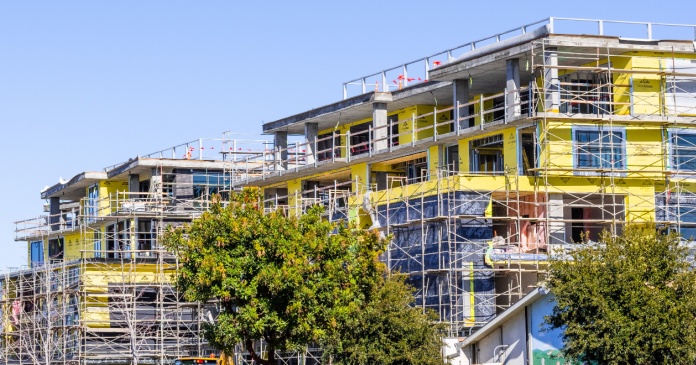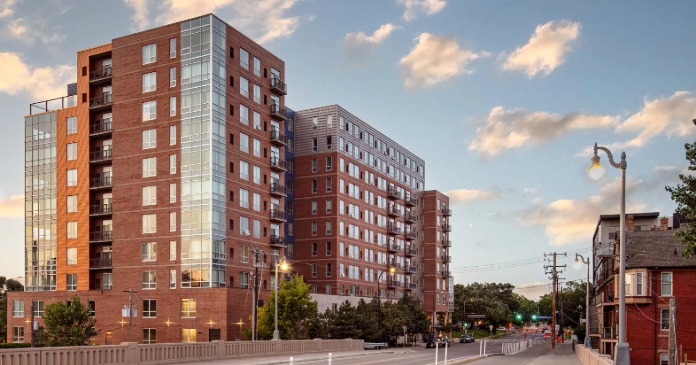Yield PRO TV presents NAHB Power Hitters. Host Linda Hoffman talks with Ann Caruana, SVP, Acquisitions of Preservation Equity Funds, WNC.
Transcript: NAHB Power Hitters interview. Linda Hoffman with Ann Caruana, recorded September 9, 2021
(music)
Linda Hoffman: Affordable housing is the answer to… well everything. From lower cholesterol to a reduction in high blood pressure. Yes. A recent study from George Washington University in Washington, D.C. found an association between heart health and housing.
We knew that.
Long before Matthew Desmond’s book, “Evicted,” housing providers intrinsically understood the direct correlation to human stability and basic function.
In fact, Wilfred Cooper Senior, founder of WNC in Irvine California, was a pioneer in affordable housing as far back as the 60s. And like any good developer, Wilfred’s feet were planted firmly on the ground. He was a master at the great balance—that is the required symmetry of social and stakeholder value.
WNC’s Preservation Equity Funds—or PEF—target affordable housing—yes—but also cash flow and investor returns. Some call those unicorns. WNC calls them deals.
Today we have the great pleasure of welcoming Ann Caruana, senior vice president, Acquisitions, Preservation Equity Fund. Ann, it’s great to have you on the show.
Ann Caruana: Thanks for having me, Linda.
Linda Hoffman: Time with Marcus & Millichap and BRE, acquired by Essex. Now VP of acquisitions and Preservation Equity Funds with WNC in Irvine, California. How’d you get here and what drives Ann Caruana?
Ann Caruana: Well, thanks for having me first of all. It’s been great 18 years to get where I’ve been. I’d say a little bit of luck and a little bit of hard work and meeting the right people. I started off, like you mentioned, in the brokerage community, which is a great kind of foot in the door to the real estate industry. I learned a lot coming up kind of through the ranks there, through BRE. I was with them for nine years in the market rate space, which is really fundamental. Once I switched over in the affordable space and kind of helping with this new strategy and driving cash flow and operations.
So, I think the key has really just been to take opportunities where they come. I’ve had a lot of different positions within my different companies where it’s working as an analyst, or managing ACT rehabs, underwriting development deal, doing research. It’s been a full circle in the business which has really positioned me well for growing this new venture with WNC.
Linda Hoffman: That sounds wide-ranging. WNC has been in the affordable space since the 70s. What’s the story behind your Preservation Equity Funds division. How does its investment strategy differ from the parent company?
Ann Caruana: Yeah, well, we’ve been in business for 50 years now. We just celebrated that anniversary—a huge milestone, thanks to Will Cooper, Senior. And, we’ve really become experts in the affordable housing space. And, that all started back in 1971 with the Low-Income Housing Tax Credit syndication business. And, today they’ve done about 11 billion in capitalization, you know, helping to provide tax credit equity to developers to help build low-income housing properties.
A very bread-and-butter business unit to the company, and very integral to the affordable housing supply production space. In 2004, the company formed Community Preservation Partners, also known as CPP. And their strategy was basically to take existing Low Income Housing Tax properties and resyndicate them. So, infuse that $50,000 to $60,000 per unit to do major ACT rehabs on those properties, extend their useful life, and also extend the affordability of regulatory restrictions on those assets, as well. So, terrific strategy for helping preserve the stock.
In 2017 is when they formed the Preservation Equity Fund, which is the group we’re talking about today. And it’s really a very complementary business unit to those two existing strategies. And that is buying existing affordable housing, but kind of in an interim period where maybe it’s not ready for an ACT rehab, but the tax credits have expired, and those investors want to get out of those deals. And so, there’s a lot of opportunities in the space to come in and acquire those assets, to manage them for cash flow and efficiencies. But then ultimately, try and help to position those to eventually go into that ACT rehab space. So, we’re going to address the deferred maintenance, and focus on the cash flow, but ultimately, we want to get those properties an additional 50 years on their useful life, and extend use agreements to keep them in the affordable stock.
Linda Hoffman: In acquiring existing affordable housing assets, you compete with other companies, and other strategies—like value-add, conversion to market rate housing. How do you compete on these bids, preserve the asset’s affordability and still provide competitive return to investors?
Ann Caruana: Well, there’s definitely a lot of like competition in space. I think, you know, when you’re talking about going up against market-rate convertors, it’s really a question of timing that is key to our strategy. And, once you get within 10 years of those regulatory restrictions expiring, you start to see a lot of those buyer types come into the market even, sometimes 15 years.
So, really, you know, trying to acquire those assets before they get to that, kind of, at risk state, and coming in before you’re going to get people, pricing in that backend—that’s going to be a lot more than what you’re budgeting. But if you can get in on the timing right, and then hold those assets for another 5 or ten years, then you can position them for the resyndication because they will become priorities for the tax credit allocations. So, it’s really about the timing on these deals.
Linda Hoffman: Federal programs are central to most affordable housing. Which programs does PEF use, and how important are they?
Ann Caruana: Well, we buy existing deals that have a number of these different programs on them. Whether their project-based Section 8, or the Low Income Housing Tax Credit, the Section 42 programs, Housing Choice vouchers, bond deals, there’s RD (rural development) deals. We don’t really look at RDs, but there’s a ton of programs that are out there. And even, there’s a ton of local programs, as well.
So, we look at a lot of it’s falling within that sort of 80 percent kind of AMI restriction—we’re interested in it and within our geographies. And, there’s ways to make all of these different programs work for our strategy. It’s a wide array and they’re all really important to addressing the affordable housing crisis.
Linda Hoffman: The Biden administration wants to expand Section 8 bigly. Is this the best path to more affordable?
Ann Caruana: Well, the Section 8 voucher program, I think is fantastic. The Low Income Housing Tax Credit program is also fantastic and I hope that they expand both, but for different reasons. So, the LITHC program is really adding more stock to the equation. LITHC program adds about 75,000 units per year, which is the largest public-private partnership in the country that’s adding that much stock. So, it’s really crucial to addressing the core issue at hand. But, the Housing Choice voucher program offers a different need for tenants, which I think is as crucially important.
It allows people choice on where they live. And a tenant-based voucher—a tenant can take that and go live near the school district that they want, near the job centers that they need to be near. It gives them options and I think anytime that you give people choice, that that is going to help with their quality of life and ultimately, their healthy outcomes.
Linda Hoffman: Multifamily housing is the bell of the CRE ball, as of late. As such, is there more competition for deals. Has this impacted investors’ expectations on returns?
Ann Caruana: I don’t think the returns are so much impacted, as it is, you know, having to find more creative ways to do deals. Having to find more creative ways to add value. You know, the multifamily space has certainly come out relatively unscathed in the last recessions. So, there’s that flight to quality that we’re seeing. There’s the super low interest rate environment. So, yeah, there’s a ton of capital in the space right now, and there’s more coming into the affordable space, but ultimately, I think that that is a good thing for our space.
I think getting more institutional capital is going to be a positive in helping solve the crisis.
Linda Hoffman: We can’t get out of this without talking about ESG investing—that’s environmental—social—governance. It’s getting a lot of attention. How does ESG impact how you do business?
Ann Caruana: ESG is a core fundamental issue and strategy to PEF and to WNC. So, on the fund level, we’re hyper focused on the environmental side of things, in that every acquisition we do, we hire an energy consultant, to come in and examine all systems to tell us where we can upgrade systems to more efficient use. And, also there are local utility companies that will help provide incentives and/or subsidies for the cost of those upgrades.
So, for example, we’re doing solar projects on four properties right now. And, the cost of those systems is about $3.2 million. We’re coming out of pocket about $70,000 for that $3.2 in cost. We’re going to get 100 percent of our electricity saved over those four properties and probably 90ish percent of the cost of electric bills to both the tenants and the common areas. So, these types of upgrades are just a triple bottom line win. The tenants save money. We save money, which actually goes back to the investors and then we’re obviously reducing our energy consumption. So, we’ve seen this play out time and again with our properties, and have been widely successful on that front.
The social aspect is kind of obvious. We’re providing affordable housing to people so, you know, that affordable rent is, by and large, the greatest amenity. But we go above and beyond that in many properties offering after school programs for some of our family deals. We offer social activities. We often partner with nonprofits and food banks to help deliver groceries at no charge to the residents each month, sometimes weekly.
And, we also partnered with nonprofits during the pandemic before there’s was CARE’S ACT money coming out to help people with money to pay their rent. So, we’re certainly focused on that aspect, as well.
And then, you know, if you go to the last letter, G for governance, I would say that that’s mostly from the WNC level—this company has 50 percent of the director level and above positions held by women or minorities, which I think is quite remarkable in today’s standard. And, really just shows how ahead of the curve WNC had been in its hiring practices and in its culture.
Linda Hoffman: Great show, Ann. This has been fascinating. Thank you for helping us to understand some very real paths forward in the affordable space.
Ann Caruana: Thanks, Linda.
Linda Hoffman: The undersupply of affordable housing—especially in the nation’s economic engines of California and New York—has been desperate, even painful. Pre-pandemic there were over a quarter of a million homeless between the two states.
A lot of money has been thrown at this issue and still the problem grows. Maybe this is the moment. Congress is discussing provisions that promise to create 1.5 million additional affordable homes across the nation over the next 10 years. A key part of this is lowering the housing bond limit from 50 to 25 percent, effectively reducing private activity bonds to 4 percent.
As with most things federal, there are far more questions than answers. Answers you can count on Yield Pro to deliver in the days ahead.
Thank you for joining us today. I hope you enjoyed our show. Look for our next exciting episode of NAHB Power Hitters.
(music and credits)












